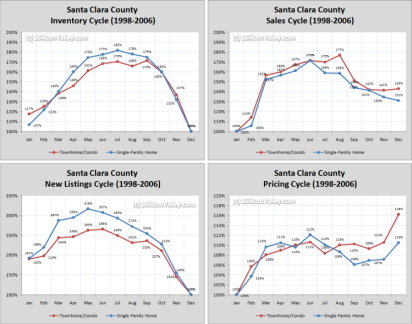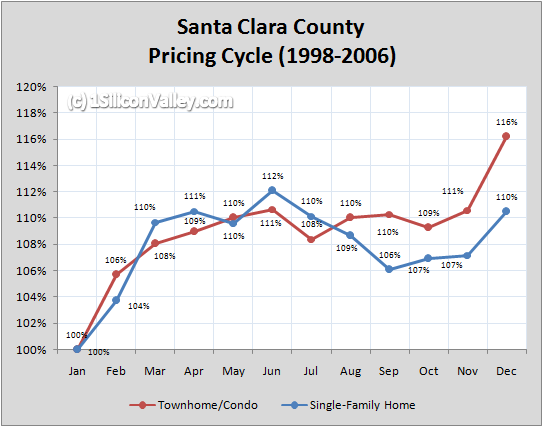The Yearly Cycles Behind the Silicon Valley Real Estate Market
My clients often ask, "What time of year is the best time to buy a house?" because they know that I won't reflexively say, "Now." To me, buying real estate is a very personal, individual decision based solely and specifically on your own needs and wants.
I believe it's best to answer with more questions. What they are depends on the people. A question about their family. About their timeframes. About their job and how much they like it. About their credit. About their perfect world and what they envision in it. This investment on my part in understanding what makes my clients tick is essential to the way I ensure clients are deliriously happy. Anyone can look up properties.
The question becomes, how do your needs and wants fit in with what the market has traditionally done since 1998? And does that mean it's the right time for you to buy a house?
Silicon Valley Inventory and New Listings Cycle
Any mutual fund commercial worth its salt has the disclaimer that past performance doesn't predict or guarantee future results. The same goes double for real estate trends and statistics, even using data back to 1998.
Inventory is one half of the balance between supply and demand. After segmenting and normalizing the inventory figures for each month from 1998 to 2006, I came up with this chart of how inventory builds up in the Silicon Valley real estate market. Historically, December has the smallest inventory, so it serves as the baseline. July traditionally has the highest inventory build up with 82% more single-family homes and 70% more townhomes and condominiums than in December.
The single-family home curve isn't a huge surprise, particularly to real estate agents, but it's interesting to note that the peak inventory for townhomes and condominiums actually happens in September (after a slight dip in August when most schools start), not July. This works out well (and sometimes best) because new competing listings drop from their peaks and prices generally hold, as you'll see in the upcoming charts.
New listings each month feed into inventory. December is the baseline month and it's not surprising that people wouldn't put their homes on the market then, given so much holiday time to work around towards the end of that month and the beginning of the new year. Listing your home in December is an easy way to make it look stale with an artificially high days-on-market number.
There's no surprise that Silicon Valley real estate (and around the country) wakes up in the spring season beginning in March with almost three times the number of new listings as in December. The seasonal peak for listing single-family homes on the market hits in May, June for townhomes and condominiums.
The Market Cycle in Number of Homes Sold in Silicon Valley
Transactions are relatively sparse in January, which acts as our baseline for comparison. Only 6% more single-family home sales and 14% more condo and townhome sales happen in February than in January, which are both traditionally very slow months in real estate, Silicon Valley and the Bay Area included.
Home sales peak in June and most condo and townhome sales peak in August. But while the drop-off in volume between August (again, when school starts) and September is particularly dramatic for townhouses and condominiums, there isn't a corresponding drop off in the average price.
Price Cycles in the Silicon Valley Real Estate Market
In fact, buying a townhome or condo in Silicon Valley and the Bay Area tends to be a more expensive proposition in December than in any other month. This doesn't mean that the price of the same home is going to be higher. It means that the ones that sell tend to have higher price trends.
January, again, acts as our baseline and common interest developments tend to be 16% more expensive in December than in January. That doesn't mean the townhome you're looking at in November will all of a sudden jump in price come Christmas: it means that there needs to be enough incentive to complete a deal during the December holiday period --- you're not looking at a lot of inventory or new listings then. It's similar, but less dramatic for single-family homes.
To create the pricing cycle graphs, I used the average sale price instead of the median which I use in the market updates. Median numbers are good for housing price updates because they don't allow one large sale to skew the data set. But averages make more sense in this large data set which incorporates 9 years of data. Please also note that the scale is 2% per unit.
When Is the Best Time to Buy a Home?
Again, I believe it's best to answer the question about when the right time is to buy a home with more questions that let me optimize for your situation. But there are a few general patterns that you can follow in the meantime depending on your overriding need or want. In planning timeframes, remember that it usually takes clients a few weeks, sometimes months, to identify the right home.
1) Schools. Schools are an overriding factor many of my clients' decisions to buy a home. For those with school age children, the best time to buy a home is after their current school year is finished, leaving enough time to get settled in before the school year starts up again. I have experience as a youngster moving during the school year and I heartily recommend to parents that they avoid it if at all possible. Generally, this means the best time is June or July.
2) Making a deal. For people who value a generally lower price over getting exactly what they want, there are the first two months of the year, particularly for homes that have been languishing since October or November. Some may be good real estate priced incorrectly. Homes generally don't sell in January and February because of a dearth of qualified and active buyers, so there will be less competition for properties. (The most desirable real estate in Silicon Valley will always have some --- and sometimes fierce --- competition. If these were the most desirable properties, and were priced correctly, they would have sold already.) The trade-off is that there will be less inventory to choose from, almost half of what's available in July.
3) Selection. People who are selective or looking for specific characteristics in their new home will have the best chance in May through August because of the inventory available. The shelves are stocked with a wide variety of goods and you'll stand a greater chance of getting exactly what you want. The trade-off is that you need to start early and be prepared to act since you're shopping during a peak period.
4) Balance. You won't run into families who absolutely have to make a move between school years and you won't have the inventory issues of deep winter (whatever that means in Northern California) and the holidays. The period of September to November, before Thanksgiving, works well for people without kids who want a good selection to choose from. There are also opportunities during March and April, particularly if it rains a lot and people aren't in the mood to see properties. An umbrella and a little extra leg work could mean a good deal in the right situation.
Averages Are What They Are
Here are the month-to-month numbers for Santa Clara County from January last year to April this year. I prefer to use year-over-year numbers in comparisons because it eliminates some of the noise caused by natural market cycles. Apples to apples.
You can see the traditional June peaks but there are lulls in December where a bump might have been expected given the averages. Just like every person is different, every year is different. That's why it's so important to make the right decision for your own needs, choose the best time for you to buy, and plan ahead so that you can weather out and benefit from whatever the market decides to do. You can't change the market, but you and I can ensure you have every possible advantage.






